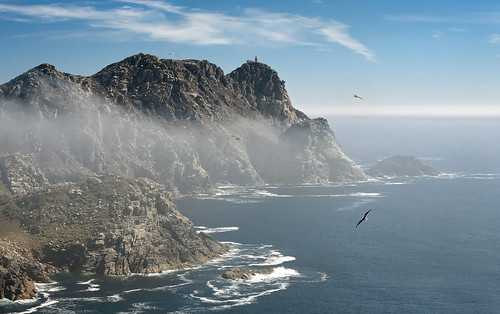This
is the last post of the series about Biodiversity on Islands. After talking
about Island characteristics and Island Biogeography, let’s turn to Extinction
on islands.
 |
| Cíes, by Anxo Resúa on Flickr (some rights reserved) |
The
rate of extinction on islands is very high; for example the 93% of birds’
extinctions since XVII century were on islands. The
high percent of extinctions is explained because of the fragility of the
ecosystem. That’s present on:
· Small populations· Unstable demography· Genetic problems· Extreme environmental conditions
Although
there were cases of extinctions by natural causes, during the last 500 years
the main responsible is the human, direct or indirectly.
The
only recorded case that is explained by natural causes is the example of St
Kitts (West Indies): in 1899, 2 hurricanes caused the extinction of a
subspecies of Puerto Rican Bullfinch (Loxigilla portoricensis).
In
contrast, to show you one example of the human effect on islands biodiversity,
let’s see the case of Panama Canal: since its construction in 1914, many new
islands lost biodiversity, for example Barro Colorado Island (Panama) has lost
20% of birds.
There
are 5 main causes of extinction on islands.
1. Habitat loss, by direct destruction (for example, deforestation) or by introduction of species. Some of the most destructive introduced species were Rabbits (Oryctolagus cuniculus), Goats (Capra pyrenaica) and Sheep (Ovis aries), which are carried by sailor in their boats as power supply; destroyed whole islands during Colonization. Their high metabolic rate and the absence of competitors and predators (on the islands where they arrived) are the reasons for their success.
1. Habitat loss, by direct destruction (for example, deforestation) or by introduction of species. Some of the most destructive introduced species were Rabbits (Oryctolagus cuniculus), Goats (Capra pyrenaica) and Sheep (Ovis aries), which are carried by sailor in their boats as power supply; destroyed whole islands during Colonization. Their high metabolic rate and the absence of competitors and predators (on the islands where they arrived) are the reasons for their success.
2. Competition among different species
3. Entrance
of pathogens
These
last two are some of the most important causes of extinction. Moreover, in most
cases they are result of introduced species. This is the example of Blue Lorikeet
(Vini peruviana), a small lorikeet
from French Polynesia and the Cook Islands, who is endangered primarily by Cats
(Felis catus), Rats (Rattus sp.) and avian malaria carried by
mosquitoes.
4. Hunting is another cause, especially with very rare and exotic species.
4. Hunting is another cause, especially with very rare and exotic species.
One
of the saddest example of hunting is the case of Dodo (Raphus cucullatus), from Mauritius Islands, a flightless bird extinct
about 1662. When humans settled there at the beginning of XVII century, Dodos
were fearless of humans: they haven’t meet predators before. Colonizers picked
up them and killed them because of their meat. At the same time, humans destroyed the Dodo's
habitat forest and introduced competitors, especially the Pigs (Sus scrofa) and Macaques (Macaca sp.). These two impacts had on
the Dodo population are actually considered as more severe than hunting; anyway,
humans are the responsible for this extinction.
5. Predation
5. Predation
Maybe,
together the habitat loss; the most devastating cause of extinction on islands
is the predation. Most cases, as well as it occurs with pathogens and
competitors, predators are introduced species which do away with native species
on islands without predators before. Thereby, the animal who is responsible of
most extinctions on islands, specially on Pacific; is the Rat (Rattus sp.), who attacks eggs of birds
and chicks.
In
Spain, a serious problem is the case of the American Mink (Neovison vison) on Cíes Islands, on the Atlantic Islands of Galicia
National Park. The American Mink is escaping from farms, and reaching islands by
swimming. There, they attack many birds, specially the European Shag (Phalacrocorax aristotelis).
That
ends the third part of the series about Biodiversity on Islands.
To
sum up, these are the main ideas:
- The special characteristics of island ecosystems are consequence of isolation and its origin (Continental vs. Oceanic islands)
- The distribution of species on islands depends on the size and the distance to the mainland.
- Humans cause (direct or indirectly) the high extinction patterns on these delicate ecosystems.
Understanding the function of
Islands Ecosystems and the human impacts on them must be the first step to develop
an efficient politic of conservation.
Bibliography and links:
- Case, T.J. 1978. A general explanation for insular body size trends in terrestrial vertebrates. Ecology, 59: 1–18.
- Crosby, A. W. 1986. Ecological Imperialism: the Biological Expansion of Europe 900–1900. Cambridge University Press.
- Lombardero, X. 2009. El visón americano ya está por toda Galicia y amenaza las aves acuáticas. La Voz de Galicia: 05/12/2009.
- Margalef, R. 1993. Teoría de los sistemas ecológicos. Universitat de Barcelona.
- Pianka, E. R. 1978. Evolutionary ecology. Harper & Row.
- Quammen, David. 1997. The Song of the Dodo: Island Biogeography in an Age of Extinctions. Simon & Schuster, New York.
- Sax, D. F. & Gaines S. D. 2008. Species invasions and extinction: The future of native biodiversity on islands. PNAS, 105: 11490-11497.
- Wihttacker, R. J., Fernández-Palacios, J. M. 2007. Island Biogeography: ecology, evolution and conservation. Oxford University Press.
- Vigo, R. S. 2012. La Xunta espera erradicar 50 visones en Islas Cíes y Sálvora. Atlántico: 06/04/2012.

No hay comentarios:
Publicar un comentario